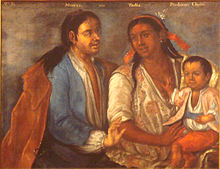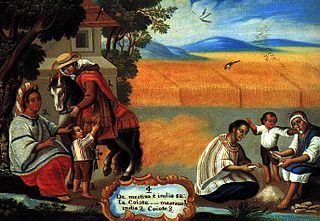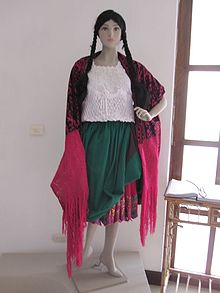- Cholo
-
Cholo (Spanish pronunciation: [ˈtʃolo]) is an ethnic slur created by Hispanic criollos in the 16th century, and it has been applied to individuals of mixed or pure American Indian ancestry, or other racially mixed origin. The precise usage of "cholo" has varied widely in different times and places. In modern American usage, it most often applies to a low-income Mexican-American sub-culture and manner of dress.
Contents
Historical usage
The term's use is first recorded in a Peruvian book published in 1609 and 1616, the Comentarios Reales de los Incas by Inca Garcilaso de la Vega. He writes (in Spanish) "The child of a Black male and an Indian female, or of an Indian male and Black female, they call mulato and mulata. The children of these they call cholo. Cholo is a word from the Windward Islands; it means dog, not of the purebred variety, but of very disreputable origin; and the Spaniards use it for insult and vituperation".[1]
In Colonial Mexico, the terms cholo and coyote co-existed, indicating mixed Mestizo and Amerindian ancestry. Under the casta system of colonial Latin America, cholo originally applied to the children resulting from the union of a Mestizo and an Amerindian; that is, someone of three quarters Amerindian and one quarter Spanish ancestry. Other terms (mestizo, castizo, etc.) were used to denote other ratios of smaller or greater Spanish-to-Amerindian ancestry.
The word "xolotl" (pronounced "cholotl") is an Aztec word which refers to a humanoid creature with dog features. It is from this meaning that the word "cholo" developed its negative connotation, taking on a similar meaning to "mutt" as applied to humans.
Cholo as an English-language term dates at least to 1851 when it was used by Herman Melville in Moby Dick referring to a Spanish speaking sailor, possibly derived from the Windward Islands reference mentioned above. Isela Alexsandra Garcia of the University of California at Berkeley writes that the term can be traced to Mexico, where in the early part of the last century it referred to "culturally marginal" mestizos and Native American origin.[2]
An article in the Los Angeles Express of April 2, 1907, headlined "Cleaning Up the Filthy Cholo Courts Has Begun in Earnest," uses the terms cholos and Mexicans interchangeably.[3] The term cholo courts was defined in The Journal of San Diego History as "sometimes little more than instant slums as shanties were strewn almost randomly around city lots in order to create cheap horizontal tenements."[4]
Modern usage
United States
In modern usage in the United States, the term "cholo" usually indicates a person of Mexican or Mexican-American descent who is associated with a particular Southwestern gangster culture. The term is used in Caló slang, but it in turn has infiltrated into mainstream American English use, specifically in association with American youth movements such as the "lowrider" subculture, or the hip hop scene in general. The word is sometimes associated with Hispanic gang culture, especially in popular media, but the origin and history of the modern usage is somewhat complex.
Racial and cultural status, along with social class are reflected in the term cholo itself, which was adopted in California in the 1960s by youth following the pachuco tradition, as a label for that identity (Cuellar 1982). In 1571, Fray Alonso de Molina, in his Nahuatl vocabulary (Vocabulario en Lengua Castellana y Mexicana Y Mexicana y Castellana), defined the word xolo as slave, servant, or waiter. The Porrúa Dictionary defines cholo, as used in the Americas, as a civilized Native American or a half-breed or mestizo of a European father and Native American mother. The word has historically been used along the borderland as a derogatory term to mean lower class Mexican migrants, and in the rest of Latin America to mean an acculturating Indian or peasant.[5]
Despite, or because of, its long history of denigrating semantics, the term Cholo was turned on its head and used as a symbol of pride in the context of the ethnic power movements of the 1960s.[6]
Fashion stereotypes
A cholo is stereotypically male, depicted as wearing loose fitting khaki pants or shorts, with white knee-high socks, creased jeans, so-called "wifebeater" white tee shirts, and button-front shirts, commonly plaid and flannel. Cholos are known for starching and pressing their pants and shirts.[citation needed] Cholos often wear military-style webbed belts.[citation needed] Cholos in the 1990s and 2000s frequently have their hair buzzed very short, though some continue to have the more traditional slicked-back hair, sometimes held in place by a hairnet or a bandana.
Footwear may include traditional athletic shoes, such as Converse, Nike Cortez, Stan Smith brand Adidas, slip-on house shoes or Huarache sandals. Popular "Cholo" brands include Dickies, Ben Davis, Joker, Lowrider, and Bighouse.
Some cholos, particularly older cholos, or cholos wishing to adopt a more refined look, wear formal wear inspired by zoot suit fashion, including dress shirts with suspenders, and fedora hats, but may still retain cholo elements such as a bandana or hair net. Cholos are not traditionally found in rural areas. In South Texas, cholos are sometimes referred to as chucs or chukes. This term is short for pachucos. Tejano cholos typically make heavy use of starch on their pants but so do traditional Tejanos.
This designation may also be associated with black ink tattoos, commonly involving calligraphy and art. A cholo might also stereotypically own a lowrider. Another staple of cholo fashion is long hair tied into braids as depicted by actor Danny Trejo.
"Cholas" and "Cholitas" are females who adopt similar fashions. Cholas may wear clothing that is very similar to Cholos, such as Dickies pants or baggy jeans, tank-tops or t-shirts, as well as halter-tops or blouses. Cholas in the 1980s and 1990s often curled their hair and teased it upward, with hair gel or hairspray (the so-called "Scare-do"), and often wore black or dark lipstick and bright eyeshadow, often with penciled-in eyebrows. However, they adopted a more classic look as fashion styles changed in the late 90s. In the past, some cholas were the sisters or girlfriends of cholos, but in recent years, increasingly form gangs or cliques in their own right.[citation needed] However, individuals who dress in the cholo style aren't necessarily associated with gang culture. Some teens will dress in this style during a passing phase in high school. More recently, chola fashion has received mainstream attention in urban and popular fashion. Singers such as Fergie and Gwen Stefani have cited the chola look as a fashion influence.[7][8] Tattoo artist and glamor model Kat Von D has also mentioned that her style of make-up was influenced by the chola look.[9]
Cholo image in media
There is a reference to "The Cholo" in Assault on Precinct 13, although it is used to refer specifically to a blood oath instead of a Mexican person. LA punk rock band The Dickies recorded "I'm A Chollo" for their 1979 album "Dawn of the Dickies". In the 2004 film Napoleon Dynamite, Nano and Arturo De Silva play characters simply referred to as "Cholo No. 1" and "Cholo No. 2". In the videogame Grand Theft Auto: Vice City Stories, there is a street gang called the Cholos who resemble the stereotypical gangster image of a Cholo.[10] The term gained even further notoriety in 2007 in the United States with the song "Lean Like a Cholo" by Down AKA Kilo. Fergie's music videos "London Bridge" and "Glamorous" feature backup dancers dressed as cholas. Gwen Stefani adopted the chola image in her music videos "Luxurious" and "Hollaback Girl".[11]
The 2009 film La Mission, starring Benjamin Bratt, is an authentic representation of the style, language, cars and music associated with the Cholo culture. The 2009 Movie Bring It On: Fight To The Finish, starring Christina Milian, featured a group of cholos who dressed in the cholo style. The word is also mentioned in a few lines of the Lady Gaga song Born This Way.
Peru, Bolivia and Ecuador
In modern-day Peru and Bolivia, "cholo" is a widely used term which generally refers to people with various amounts of Amerindian racial ancestry. Among Peruvians, the term mestizo is not commonly used as part of the language or as a descriptor. In other Latin American countries, it is used for those of various proportions of Caucasian European to Amerindian ancestry.[citation needed]
The term "cholo" is becoming an element badge and unifier of the current Peru progressively. According to several specialists in the topic, it has evolved and acquired a character of gentile for the vast majority of inhabitants of the South American country.[citation needed] The Peruvians are identified themselves without complex, as "cholos". In recent years, extensive migration into larger urban centers and diffusion of cultural values beyond the cities into rural areas of Peru has resulted in shifting of meaning of "cholo" to include vast numbers of people. A good example of Peruvian usage is the case of Presidential candidate Alejandro Toledo. He was commonly referred to as el cholo in the election race. [12]
This category now encompasses[citation needed]
1) All of those of exclusively Native American ancestry;
2) Those with predominantly indigenous ancestry, independently of their social status
3) Those with any noticeable amount of Amerindian heritage further categorized by socioeconomic status.
4) A small number of African descent. Little is known or understood about this particular group, found to inhabit the Bolivian Altiplano.
The latter group may escape to such categorization based on a more "European" Caucasian appearance or a wealthier social status ("cholo con plata"). This categorization as "cholo" is independent of migratory status in relation to the rural or interior regions of the country, whether they live in urban areas and cities, whether they have taken up urban European cultural practices, and whether they are bilingual or monolingual (in Spanish or a native language such as Quechua or Aymara). This category of cholo is also independent of whether a new migrant into large urban centers identifies solely with the urban cultural norms or not. In that latter context, the usage may occur as a derogatory term when used by the upper economic strata or those of predominant white European appearance. It must be noted however that such pejorative use of the term does not conform to the generally accepted definition of cholo by the greater proportion of the mixed and native Amerindians which together comprise approximately 82% of the population. The term mestizo is not used in Peru except in remote areas by the purely Amerindian and it is only of historical interest. The term 'Indio' is reserved for the ethnic groups living in the Amazon basin or 'Selva'. The term 'Negro' (Spanish pronunciation, not American) or 'Zambo' is used for those of noticeable Black heritage, generally without pejorative meaning. See additional information on usage of these terms in more detail in Ricardo Palma's "Tradiciones Peruanas".."[13]
In Ecuador, "Cholo" is also used to denote a greater affinity for Amerindian than Spanish heritage for mixed-race people.
Cholos in Ecuador reside typically in communities whose members are mestizos whose ancestry is both Spanish and Amerindian — often greater Spanish than Amerindian. Yet apart from their apparent Spanish descent and monolingualism in Spanish, their garb, culture and customs, their traditional occupations and many times their surnames are more typical of highland Quichua Amerindians than of Spaniards. This circumstance is in contrast to the evolution of mestizo identity and life throughout the rest of Latin America, where the emphasis has always been placed solely on the Spanish side. In Ecuador as well as in Peru and Bolivia a select elite group of persons with more Caucasian "European" mores and habits, including a more white-appearing physiognomy have traditionally monopolized the social discourse and handed down labels and tags of racial and social status to the lower classes. Because of the obvious reason is to maintain their status of dominance in the realm of culture and economy, the discourse on these and other concepts by such groups is suspect of being biased towards that end.[citation needed]
A widely known example of the former are the "Cholas Cuencanas", from the colonial city of Cuenca in the southern region of that country.
When not specifically referring to the above-mentioned mixed Caucasoid-Amerindian communities, the term 'cholo' generally may convey the same connotations of Amerindian ancestry in various proportions than Spanish. Most of the population would not qualify as purely Caucasian but instead of a mixed-race person as it does in other Andean countries.
The term as used in Ecuador is supposedly a neutral term to designate the human groups described above. It may be used, however, following the colonial Spanish manner of speech as a pejorative term to disparage someone as being a member of the "lower class", a designation historically associated and usually reserved to maintain in check the social status of those of greater Amerindian admixture.[citation needed]
Mexico
The cholo gangs came to Mexico from the U.S. in the 1980s.[14] The first Mexican cholo groups came about in the 1990s, and were called by various names, such as “barrios,” “clickas” and “gangas,” and typically seen as American Hispanics, not as Mexicans because of their dress and appearance, which has never been traditional to Mexico. Many of these groups were formed by youths who had spent time in the United States and who returned with a different identity picked up in U.S. street life.[15] Most cholos are youths between 13 and 25 years old who generally do not finish school beyond the eighth grade.[14] These groups mimic the organization of gangs found in the United States, especially California. Cholos have their own style of dress and speech. They are known for hand signals, tattoos and graffiti. Groups of cholos control various territories in the city. Most of the violence among these groups is over territory.[15] Some of the better known cholo gangs in Neza are “41 Street,” “DK13,” “Cobras 13,” “Los Sur 13,” “Cobras 38,” “Los Mexican,” “Los de la 33,” “La 14” and the “Sur Kings.”[14]
The former municipal president, Luis Sánchez, states that this kind of activity is waning and claims only two cholo groups are true active gangs. The rest are imitations of the lifestyle as a type of counterculture. He also states that no more than 500 youths belong to the gangs which have been identified by the authorities. Other sources state that this is not true and more than 100 groups operate in the city with many more members.[15][14]
Chile and Argentina
In Chile, the term is used almost exclusively to refer to Peruvian and Bolivian immigrants of Amerindian appearance. Sometimes it can be used as an insult. It may also be applied to anyone of unmixed Amerindian ancestry or predominantly Amerindian appearance, except if the person is a fellow Chilean, which in that case is called 'indio/a'.
In Argentina 'Cholo' and 'Chola' are also commonly used as nicknames, not only for those who would be considered 'cholos', but also for Caucasians, such as the case of Argentine former football player Cholo Simeone.
See also
References
- ^ de la Vega, Garcilaso, Inca, (1609). Los Comentarios Reales de los Incas. pp. ME. "Aqui el escribe "Al hijo de negro y de india, o de indio y de negra, dicen mulato y mulata. A los hijos de éstos llaman cholo; es vocablo de la isla de Barlovento; quiere decir perro, no de los castizos (raza pura), sino de los muy bellacos gozcones; y los españoles usan de él por infamia y vituperio.""
- ^ Vigil, James Diego (1988). Barrio Gangs: Street Life and Identity in Southern California. Austin: University of Texas Press. ISBN 0292711190.
- ^ Author unknown. "Cleaning Up the Filthy Cholo Courts Has Begun in Earnest", Los Angeles Express, April 2, 1907.
- ^ Curtis, James R. and Ford, Larry. "Bungalow Courts in San Diego: Monitoring a Sense of Place". The Journal of San Diego History. Spring 1988, Volume 34,
- ^ Cuellar, J. (1982-09-21). "The Rise and Spread of Cholismo as a Border Youth Subculture". Southwest Border Regional Conference's Third Annual Binational Border Governors' Conference, Tijuana, Baja California, Mexico: Unpublished manuscript.
- ^ Cummings, L. (Spring 2004). "Cloth-Wrapped People, Trouble and Power: Pachuco Culture in the Southwest". Journal of the Southwest.
- ^ http://www.metronews.ca/toronto/comment/article/159048
- ^ USA Today. http://blogs.usatoday.com/entertainment/2007/08/gwen-stefani-im.html.[dead link]
- ^ http://en.terra.com/lifestyle/articles/html/hof1847.htm
- ^ Beale, Lewis (6 August 2006). "The young stars of an award-winning new film reflect on their Mexican roots.". USA Weekend.com. http://www.usaweekend.com/06_issues/060806/060806movies.html. Retrieved 11 Jan 2009[dead link]
- ^ http://www.mtv.com/news/articles/1536116/20060711/black_eyed_peas.jhtml
- ^ http://www.rpp.com.pe/2010-11-10-alejandro-toledo-vida-obra-y-escandalos-noticia_309760.html
- ^ Palma, Ricardo. Tradiciones Peruanas.
- ^ a b c d López Peña, Susana. "Los cholos de 'Nezayork' [The cholos of “Neza York”]" (in Spanish). Noticieros Televisa (Mexico City). http://www.esmas.com/noticierostelevisa/noticieros/376243.html. Retrieved 18 January 2010.
- ^ a b c Sánchez Lemus, Saúl. "La vida loca [The Crazy Life]" (in Spanish). Noticieros Televisa (Mexico City). http://www.esmas.com/noticierostelevisa/losreporteros/387110.html. Retrieved 18 January 2010.
Ethnic and religious slurs White people GeneralAmericansLimey • Mick • Paddy • Pommy • Taffy (Welsh people) • Taig (Irish Catholics) • Teuchter (Scottish Highlanders)ItaliansJewsOtherBlack people GeneralAsians ABC • Ah Beng • Chinaman • Ching chong • Chink/chinky • Coolie • Gook • Jap • Jjokbari • Jook-sing • Sangokujin • ShinaArabsOther Ajam (non-Arabs) • Batiniyya • Cholo (Mestizos) • Coonass (Cajuns) • Extracomunitario • Gâvur (non-Muslims) • Gentile (non-Jews) • Goy (non-Jews) • Infidel (non-Muslims) • Kafir (non-Muslims) • Kanaka (Pacific Islanders) • Kanake • Redskin (Native Americans) • Shegetz (non-Jewish boy or man) • Shiksa (non-Jewish women) • Squaw (Native American women)Categories:- Pejorative terms for people
- Spanish words and phrases
- Latin American caste system
- Multiracial affairs
- Social class subcultures
Wikimedia Foundation. 2010.



